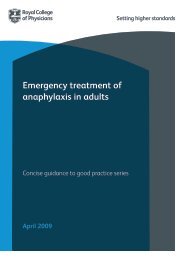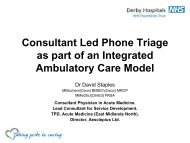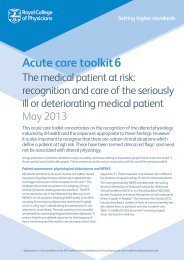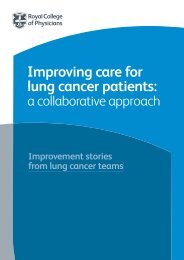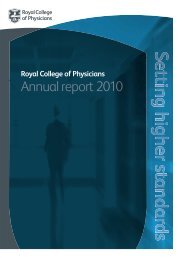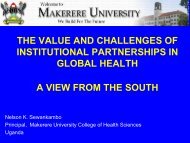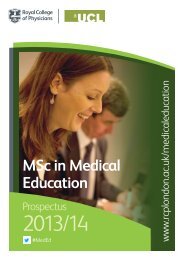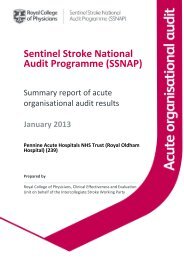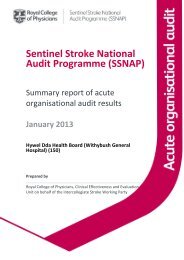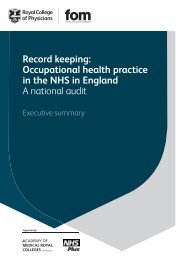Consultant physicians working with patients - Royal College of ...
Consultant physicians working with patients - Royal College of ...
Consultant physicians working with patients - Royal College of ...
You also want an ePaper? Increase the reach of your titles
YUMPU automatically turns print PDFs into web optimized ePapers that Google loves.
2 Specialties Diabetes and endocrinology8 Workforce requirements for the specialtyCurrent workforce numbersThe 2011 annual Diabetes UK RCP manpower surveyidentified 723 whole-time equivalent (WTE)consultants in the UK. These numbers give WTEconsultants per 100,000: England 1.1, Scotland 1.51,Wales 1.4 and Northern Ireland 1.67. This represents asmall overall increase in WTEs in the UK, from 1.04 in2009 to 1.16 in 2011. The number <strong>of</strong> consultants<strong>working</strong> single-handedly in hospitals is very small.There has been a rise in the numbers <strong>of</strong> postscombining acute medicine and diabetes and/orendocrinology that appears to reflect a lack <strong>of</strong> vacanciesin recent years in the specialty.Estimated number <strong>of</strong> consultants needed toprovide a specialist service for a population <strong>of</strong>250,000There has been a considerable increase in type 2diabetes prevalence and the prospect <strong>of</strong> formalscreening for diabetes is likely to result in a steep rise indemand for diabetes care; epidemiological studiessuggest that screening may double the number <strong>of</strong> thoseidentified as having diabetes. The latest DiabetesPrevalence Model (2010) from the Association <strong>of</strong> PublicHealth Observatories estimates that the prevalence <strong>of</strong>diabetes will be 8% in England by 2015.Current healthcare policy is to encourage thedevelopment <strong>of</strong> ongoing primary and intermediate carefor diabetes services. These services will, however,require support and supervision from specialists. Thecombination <strong>of</strong> these factors makes it difficult toaccurately calculate the need for specialist andsecondary diabetes care. The best current estimate isthat the increased prevalence and longevity <strong>of</strong> people<strong>with</strong> diabetes and the increased complexity <strong>of</strong> care, plusthe provision <strong>of</strong> new care models, will mean an increasein the workload <strong>of</strong> diabetes specialists. The work <strong>of</strong> thespecialist is likely to change over time, <strong>with</strong> moreemphasis on work outside secondary care but also anincrease in work focused on in<strong>patients</strong> <strong>with</strong> diabetes.For endocrinology, it is also expected that thedevolution <strong>of</strong> more routine care will be balanced by theincreased complexity <strong>of</strong> treatment options for rareconditions. Table 1 shows a recommendation <strong>of</strong> whatcould be regarded as the minimum involvement indiabetes and endocrinology to provide a service for a250,000 population. It is expressed as time divided intoprogrammed activities (PAs) (4-hour sessions). Thisanalysis is for a consultant-provided service and doesnot accurately take outpatient activity by other gradesinto account. The demands <strong>of</strong> acute medicine onspecialty registrars (StRs) and the need to supervisejuniors mean that most consultants feel that it is notpossible to quantify the input from them. Some centresrun parallel nurse-led clinics, which are not included.Table 1 shows that for the specialty commitment alonefor a 250,000 population there is a need for at least 4consultants in endocrinology and diabetes, <strong>with</strong> a10-PA contract allowing for a GIM/acute medicinecomponent and for supporting pr<strong>of</strong>essional activities.No allowance has been made for managerial, regional ornational roles. This would require 877 WTEs atconsultant level for England and Wales (609 in 2011).9 <strong>Consultant</strong> work programme/specimenjob planThe programme in Table 2 assumes the above estimatednumber <strong>of</strong> <strong>physicians</strong> sharing a general medicalcommitment and <strong>working</strong> a 10-PA contract. This wouldfit a typical district general hospital in diabetes andendocrinology and would be different for morespecialised or academic posts. Many <strong>of</strong> the activities aregiven as a range because individual posts will varywidely even in a single department.10 Key points for commissioners1 Diabetes is rapidly increasing in prevalence,consumes about 10% <strong>of</strong> NHS resources and usesabout 17% <strong>of</strong> NHS beds.2 Many diabetic <strong>patients</strong> (eg those <strong>with</strong>uncomplicated type 2 diabetes) can be cared for inprimary care.3 Nevertheless, many will need secondary carespecialty teams. These include most type 1 andcomplex type 2 <strong>patients</strong>.4 Mandatory areas for secondary care includediabetic pregnancy, transitional (adolescent) careand diabetic foot ulceration.5 Secondary care will also lead complex newtreatments, eg insulin pumps, GLP1 agonists.6 Educational systems (eg DAFNE, DESMOND andXPERT) need support in both primary andsecondary care.7 A smooth interface for diabetes care betweenprimary and secondary care is vital and will behelped by community diabetologists and GPwSIs.C○ <strong>Royal</strong> <strong>College</strong> <strong>of</strong> Physicians 2013 95



